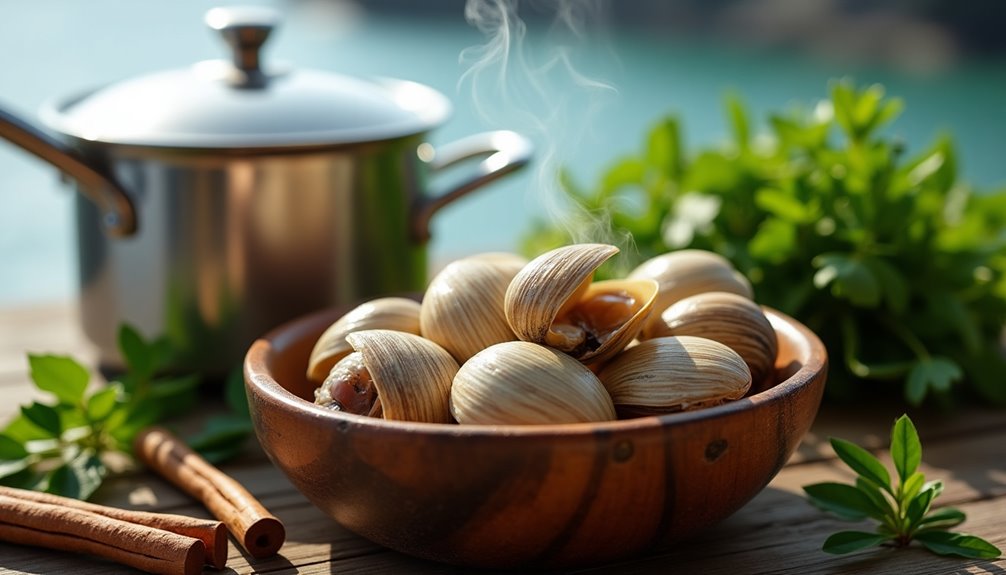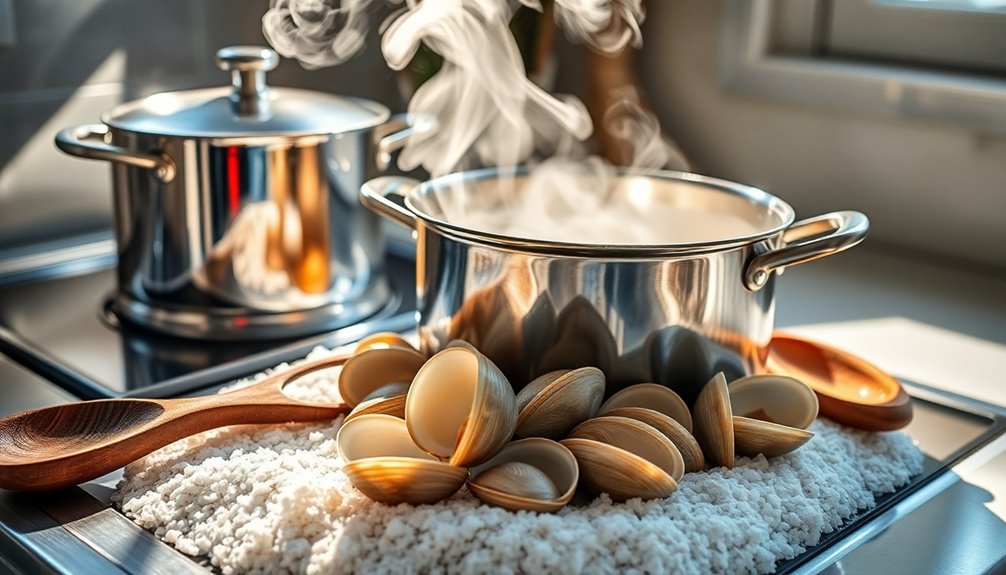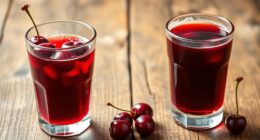To make clam juice, start by rinsing high-quality fresh clams to remove sand. In a stock pot, cover the clams with cold water and bring to a boil over medium-high heat. Steam the clams until they open, usually 3-5 minutes, then discard any that remain closed. Strain the liquid through a fine mesh strainer for clear clam juice. Store it in airtight containers in the fridge or freeze it for later use. Want to explore more culinary uses for clam juice?
Key Takeaways
- Select high-quality fresh clams and rinse them thoroughly to eliminate sand and dirt before cooking.
- Cook clams in a stock pot with cold water, covering them, and steam until they open (3-5 minutes).
- Discard any unopened clams for safety after cooking, as they are not safe to consume.
- Strain the cooked liquid through a fine mesh strainer or coffee filter to collect clear clam juice.
- Store clam juice in airtight containers in the refrigerator for up to a week or freeze for longer storage.

Making clam juice at home is simpler than you might think. With just a few fresh clams and a little effort, you can create a flavorful broth that enhances your soups and stews or serves as a base for various seafood dishes.
The process starts with sourcing some high-quality fresh clams. When you bring them home, it's essential to rinse them thoroughly to remove any sand or dirt. A clean clam ensures a better clam juice without unwanted grit.
Once your clams are cleaned, it's time to get cooking. Grab a stock pot and combine the clams with cold water. Make sure the water covers them adequately. Cover the pot and bring the mixture to a boil over medium-high heat. As the clams begin to steam, you'll notice them opening up. This typically takes about 3-5 minutes.
Keep an eye on the clams, and once they've all opened, you're on your way to making delicious homemade clam juice. While you're cooking, it's crucial to pay attention to any clams that don't open. You'll want to discard any unopened clams, as they're no longer safe to consume.
Safety should always come first in your cooking adventures, and this rule applies to clam preparation just as it does to any other food. Once you've removed the unopened clams, you'll be left with a pot full of steamy, flavorful clams and broth.
Next, it’s time to strain your clam broth to create that lovely clam juice. Using a fine mesh strainer or a coffee filter, pour the liquid through to remove any remaining debris. This step helps ensure that your clam juice is clear and free from any particles. Once your clam broth is perfectly strained, you can set it aside to cool while you prepare your favorite dishes. If you’re in the mood for something fun and creative, consider experimenting with a different recipe entirely by learning how to make guava juice slime. This unique treat combines the sweetness of guava with a playful texture, making it a hit for parties or as a fun activity with kids. You can also use your clam juice as a base for delicious soups and stews, enhancing the overall flavor profile of your dishes. If you’re looking to elevate your culinary skills further, you might want to explore how to prepare concentrate juice, which allows you to create vibrant and flavorful beverages from your favorite fruits. Whether you’re whipping up a refreshing drink or introducing new flavors to your cooking, understanding these techniques can open up a world of delicious possibilities.
The resulting liquid is your homemade clam juice, which can be used in a multitude of ways. You can store your clam juice in the refrigerator for up to a week, making it convenient for future culinary creations.
Use it as a base for rich, savory soups and stews, or incorporate it into sauces for an extra layer of flavor. The clam stock you've prepared can elevate any seafood dish, adding a depth that's hard to achieve otherwise.
Frequently Asked Questions
How Do They Make Clam Juice?
To make clam juice, they start by steaming fresh clams, which releases a flavorful liquid.
After boiling the clams for about 3-5 minutes, they discard any that don't open.
The resulting liquid, called clam liquor, gets strained to remove solids, often using a coffee filter for clarity.
Some might add ingredients like white wine or garlic during steaming to enhance the flavor.
Finally, the juice can be stored in the refrigerator for about a week.
Is Clam Broth the Same as Clam Juice?
When it comes to clam broth and clam juice, they're not exactly two peas in a pod.
Clam broth is typically salt-free and seen as a more natural option, while clam juice usually packs a salty punch for flavor.
Both come from steaming clams, but their taste and uses can differ.
You'll find clam broth's richer flavor shines in soups, while clam juice enhances various dishes.
Can I Use the Juice From a Can of Clams?
Yes, you can definitely use the juice from a can of clams! It's a convenient and flavorful substitute for clam juice in your recipes.
Just keep in mind that canned clam juice often contains added salt, so you might want to adjust your dish's seasoning accordingly.
The liquid from canned clams shares similar nutrients and flavors with homemade clam juice, making it a practical choice when you're short on time.
Where Do You Get Clam Juice From?
Finding clam juice's like searching for treasure at the bottom of the ocean.
You can grab it at most grocery stores, typically in the canned seafood or broth aisle.
If you're after a fresher taste, check out specialty food stores or local seafood markets, which might offer it straight from steamed clams.
Online retailers also have a variety of bottled clam juices, so you can easily stock up without leaving home.
Conclusion
Now that you know how to make clam juice, why not dive in and give it a try? With just a few simple steps, you'll be savoring that briny flavor that brings seafood dishes to life. Imagine the rich, ocean-inspired aroma wafting through your kitchen as you create this versatile ingredient. So grab your clams and get started—your taste buds will thank you for the delicious adventure ahead! After all, isn't cooking just a journey in flavor?
Cindy thoroughly researches juicing trends, techniques, and recipes to provide readers with practical advice and inspiration. Her writing style is accessible, engaging, and designed to make complex concepts easy to understand. Cindy’s dedication to promoting the advantages of juicing shines through her work, empowering readers to make positive changes in their lives through the simple act of juicing.











